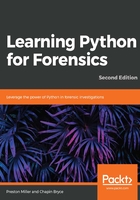
Summary
This chapter has covered a wide range of introductory content that provides a foundation to be built upon throughout the duration of this book; by the end, you will become well-versed in Python development. These topics have been handpicked as the most important items to comprise a basic understanding of the language as we move forward. We have covered data types, what they are and when they are used, variable naming and the associated rules and guidelines, logic and operations to manipulate and make decisions based on values, and conditions and loops that provide a sequential organization for our scripts and form the baseline of everything we develop. The code for this project can be downloaded from GitHub or Packt, as described in the Preface.
Please consider re-reading this chapter and working through the examples multiple times to help with comprehension. Just like anything else, learning a new language requires a lot of practice.
Through these features alone, we can create basic scripts. Python is a very powerful and complex language belying its simplistic syntax. In the next chapter, we will explore more complex foundational items and continue expanding upon knowledge established in this chapter, prior to moving on to real-world examples.